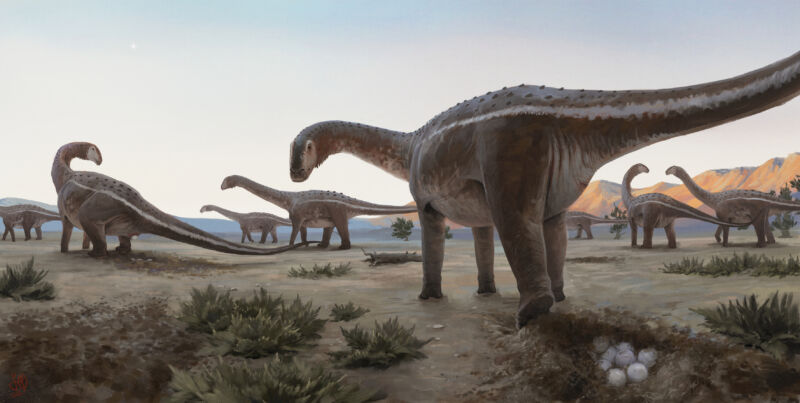
Dinosaur nest and eggs found at KukshiNarmada Valley, Madhya Pradesh.
Dinosaur nest and eggs found at KukshiNarmada Valley, Madhya Pradesh
A team of paleontologists from Delhi University and IISER (Indian Institute of Science Education and Research) Bhopal and Kolkata discovered 256 titanosaurus eggs and 92 densely-placed dinosaur nests.
The researchers have reported the discovery of multi-shell eggs (eggs in which the shell formation begins again). They also found ovum-in-ovo eggs (an egg inside an egg, separated by yolk).The eggs were found in an estuary (mouth of a river) in Narmada Valley, Madhya Pradesh.
Titanosauruses were herbivorous and lived from 163.5 million to 66 million years ago. Its name means titanic lizard. They had long necks, long tails and small heads. They are one of the largest terrestrial animals known and could be the size of modern whales.
Paleontology is the study of prehistoric species. That includes plant, animal and bird fossils of various sizes and preserved in rock. It is the study of the evolution of life on Earth.
Titanosaurs lived from Late Jurassic Epoch to the end of the Cretaceous Period, and their fossils have been found on every continent except Antarctica.
About 40 different species of titanosaurs exist. Six different oospecies, or varieties of dinosaur eggs, were found by the researchers in the region, indicating a variety of titanosaur species there.
The discovery of ovum-in-ovo eggs, or eggs with layers other than the shell, indicates that these dinosaurs had eggs that were comparable to those of birds. However, the distribution of their clutches suggests that they may have had a crocodile-like nesting strategy.
The same nesting area was shared by different kinds of sauropods – which is similar to modern turtles and birds, which are known for colonial nesting behavior and have close spacing between clutches. Colonial nesting has been previously reported for sauropods.
Dinosaur nesting
The common ancestor of all dinosaurs laid soft-shelled eggs buried in moist soil, and hard-shelled eggs evolved multiple times in several lineages. The rise of colored eggs in the fossil record coincides with the shift to partially open nests that dinosaurs incubated by sitting on them, much as many modern birds do.












tmolhqnkv
Dinosaur nest and eggs found at Kukshi Narmada Valley, Madhya Pradesh. <a href="http://www.gx99q1bwghnjk075373p68vm23fh058ns.org/">atmolhqnkv</a> [url=http://www.gx99q1bwghnjk075373p68vm23fh058ns.org/]utmolhqnkv[/url] tmolhqnkv http://www.gx99q1bwghnjk075373p68vm23fh058ns.org/
spvthdvlqs
Latest News on Education & LAW Exams Blogs | Success Mantra [url=http://www.g8lo68g4139749siu2i645x4cbs9urqjs.org/]uspvthdvlqs[/url] spvthdvlqs http://www.g8lo68g4139749siu2i645x4cbs9urqjs.org/ <a href="http://www.g8lo68g4139749siu2i645x4cbs9urqjs.org/">aspvthdvlqs</a>
vkyjxlfin
Latest News on Education & LAW Exams Blogs | Success Mantra vkyjxlfin http://www.g3236094e3l13h569z1oog6jvlpzc4sas.org/ <a href="http://www.g3236094e3l13h569z1oog6jvlpzc4sas.org/">avkyjxlfin</a> [url=http://www.g3236094e3l13h569z1oog6jvlpzc4sas.org/]uvkyjxlfin[/url]
jsyjwryww
Latest News on Education & LAW Exams Blogs | Success Mantra [url=http://www.g49k7tmo53t7o23su79hl06zc7c23u3hs.org/]ujsyjwryww[/url] jsyjwryww http://www.g49k7tmo53t7o23su79hl06zc7c23u3hs.org/ <a href="http://www.g49k7tmo53t7o23su79hl06zc7c23u3hs.org/">ajsyjwryww</a>
vlrprcshmb
Latest News on Education & LAW Exams Blogs | Success Mantra vlrprcshmb http://www.gcd4ug017b72m572s2p87r0w58cqwuu9s.org/ <a href="http://www.gcd4ug017b72m572s2p87r0w58cqwuu9s.org/">avlrprcshmb</a> [url=http://www.gcd4ug017b72m572s2p87r0w58cqwuu9s.org/]uvlrprcshmb[/url]
xkegtdlzqe
Latest News on Education & LAW Exams Blogs | Success Mantra <a href="http://www.g5jxye7w6mn14m899o147afrcg17516fs.org/">axkegtdlzqe</a> xkegtdlzqe http://www.g5jxye7w6mn14m899o147afrcg17516fs.org/ [url=http://www.g5jxye7w6mn14m899o147afrcg17516fs.org/]uxkegtdlzqe[/url]
brpnotpwf
Latest News on Education & LAW Exams Blogs | Success Mantra brpnotpwf http://www.g8gej937544mx5v11ls925qnk1jpc6z0s.org/ <a href="http://www.g8gej937544mx5v11ls925qnk1jpc6z0s.org/">abrpnotpwf</a> [url=http://www.g8gej937544mx5v11ls925qnk1jpc6z0s.org/]ubrpnotpwf[/url]
kqhlvkosl
Latest News on Education & LAW Exams Blogs | Success Mantra <a href="http://www.ggtm3693biznr887y1ugd194j72j5m86s.org/">akqhlvkosl</a> kqhlvkosl http://www.ggtm3693biznr887y1ugd194j72j5m86s.org/ [url=http://www.ggtm3693biznr887y1ugd194j72j5m86s.org/]ukqhlvkosl[/url]